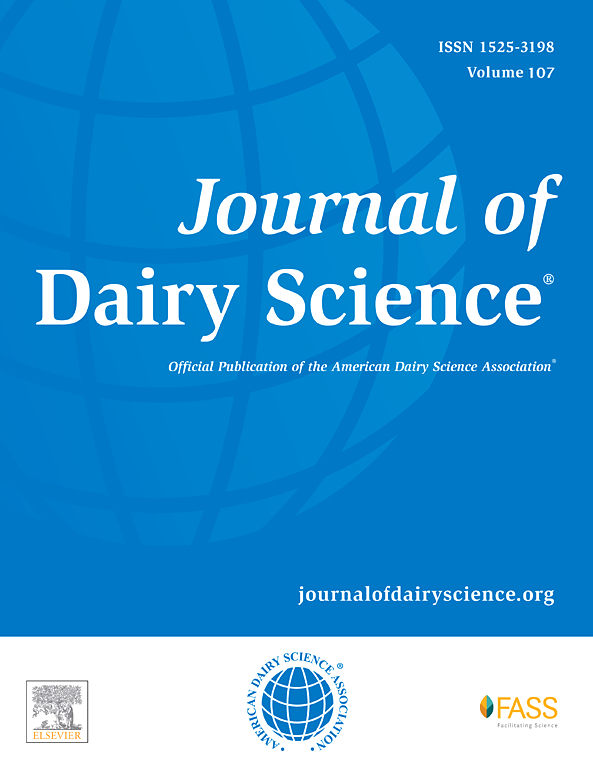Effect of proportion of pasture in the cow diet and seasonality on the milk metabolome as determined by 1H-NMR
IF 3.7
1区 农林科学
Q1 AGRICULTURE, DAIRY & ANIMAL SCIENCE
引用次数: 0
Abstract
This study investigates the effect of varying proportions of pasture (high, medium, no-pasture) in the diet of cows and seasonality on the milk metabolome throughout lactation using proton nuclear magnetic resonance (1H-NMR) spectroscopy. This study explored the potential to differentiate milks from varying levels of pasture in the cow's diet and highlight potential biomarkers for authentication. A total of 54 spring calving cows were assigned to the 3 diet treatments for the duration of lactation. Weekly bulk milk samples were collected from each herd. Over 37 wk (March–November 2020), 43 metabolites representing diverse chemical classes, including AA and nitrogenous compounds, carbohydrates, VFA, organic acids, and alcohols were quantified. Significant dietary and seasonal influences on the milk metabolome were characterized, with signature differences attributed to the proportion of pasture in the cow's diet and the season of milk production. Receiver operating characteristic analysis of the milk from different feeding systems across lactation highlighted the potential of the milk metabolome to distinguish pasture from nonpasture-derived milks, with a series of metabolites demonstrated as excellent biomarkers, including hippurate. Multivariate analysis also highlighted dimethyl sulfone as a key metabolite for the distinction between different diet regimens. These findings highlight the diversity and complexity of the composition of milk as affected by seasonality, and signature characteristics that are associated with pasture-based feedings systems. As “grass-fed” dairy products become more prominent on the market, the analysis of the milk metabolome using 1H-NMR shows significant promise for utilization as a tool for authentication purposes.
奶牛日粮中牧草比例和季节对牛奶代谢组的影响。
本研究利用质子核磁共振(1H-NMR)波谱技术研究了奶牛日粮中不同比例的牧场(高、中、无牧场)和季节对泌乳期牛奶代谢组的影响。本研究探讨了区分奶牛日粮中不同牧草水平的牛奶的潜力,并突出了潜在的生物标志物进行鉴定。在哺乳期间,共有54头春季产犊奶牛被分配到3种日粮处理中。每周从每个牛群中采集散装牛奶样本。在37周(3月至11月)的时间里,43种代谢物代表了不同的化学类别,包括氨基酸和氮化合物、碳水化合物、挥发性脂肪酸、有机酸和醇。饲粮和季节对牛奶代谢组有显著影响,显著差异归因于奶牛日粮中牧草的比例和产奶季节。对哺乳期不同喂养系统的牛奶进行的受试者工作特征(ROC)分析强调了牛奶代谢组区分牧场和非牧场衍生牛奶的潜力,其中一系列代谢物被证明是优秀的生物标志物,包括马粪酸。多变量分析也强调了二甲基砜是区分不同饮食方案的关键代谢物。这些发现强调了受季节性影响的牛奶成分的多样性和复杂性,以及与牧场喂养系统相关的标志性特征。随着“草饲”乳制品在市场上的地位越来越突出,使用1H-NMR对牛奶代谢组进行分析显示出作为认证工具的巨大前景。
本文章由计算机程序翻译,如有差异,请以英文原文为准。
求助全文
约1分钟内获得全文
求助全文
来源期刊

Journal of Dairy Science
农林科学-奶制品与动物科学
CiteScore
7.90
自引率
17.10%
发文量
784
审稿时长
4.2 months
期刊介绍:
The official journal of the American Dairy Science Association®, Journal of Dairy Science® (JDS) is the leading peer-reviewed general dairy research journal in the world. JDS readers represent education, industry, and government agencies in more than 70 countries with interests in biochemistry, breeding, economics, engineering, environment, food science, genetics, microbiology, nutrition, pathology, physiology, processing, public health, quality assurance, and sanitation.
 求助内容:
求助内容: 应助结果提醒方式:
应助结果提醒方式:


